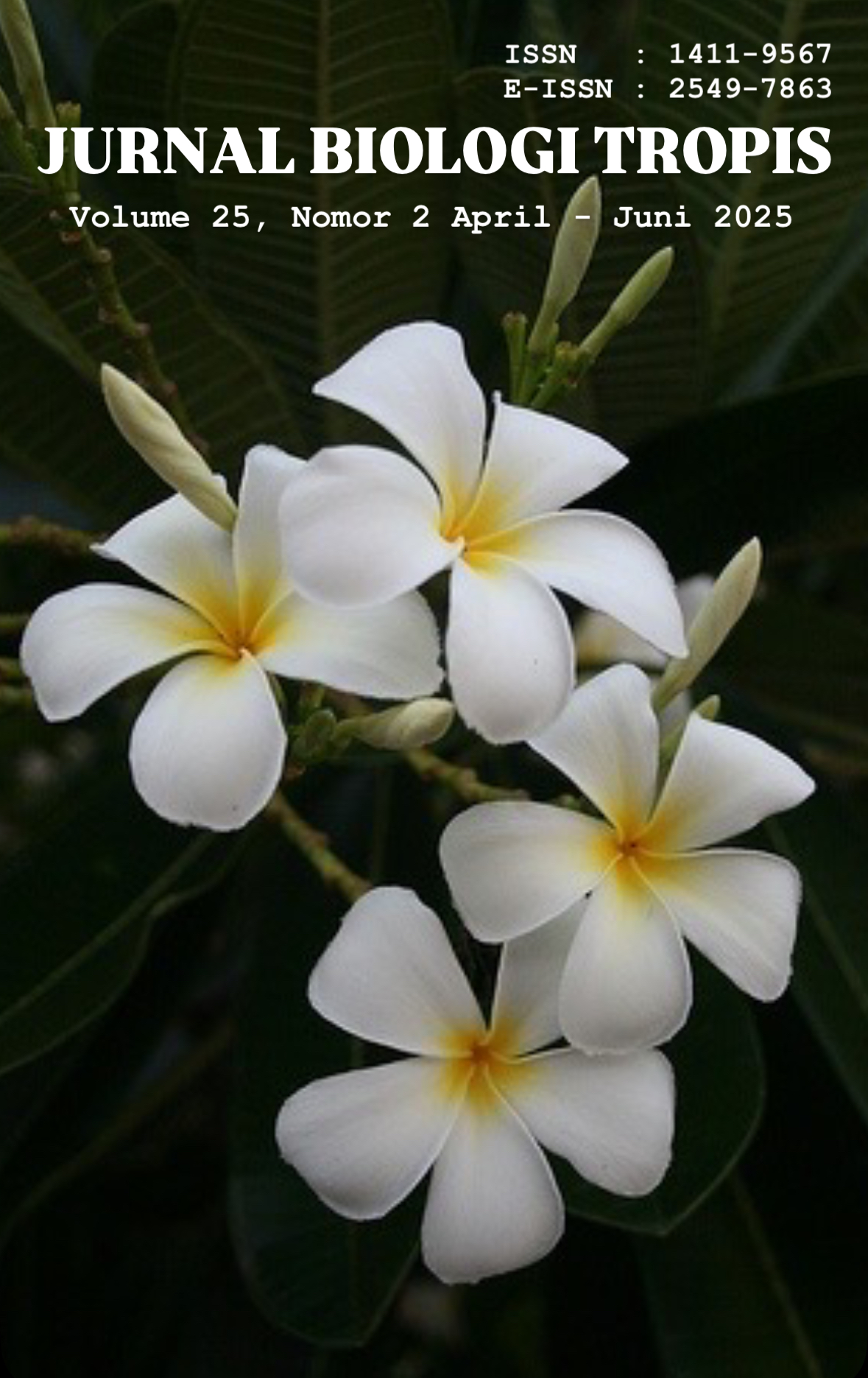Morphometric Analysis of Apis dorsata Bees in North Lombok Regency
Authors
Dany Alfian Herlambang , M. Nu'aim Hasbihan , Erwan Erwan , Muhammad MuhsininDOI:
10.29303/jbt.v25i2.8870Published:
2025-04-21Issue:
Vol. 25 No. 2 (2025): April-JuniKeywords:
Apis dorsata; Biodiversity; Body weight; Morphometric analysisArticles
Downloads
How to Cite
Downloads
Metrics
Abstract
The giant honeybee (Apis dorsata) is vital for ecosystems as a pollinator, significantly impacting agricultural productivity, biodiversity, and food sustainability. This study explores the morphometric characteristics of Apis dorsata populations in Batu Rakit Village, North Lombok Regency, a tropical region with rich biodiversity. Morphometric data were collected from 20 worker bees, focusing on body length, abdomen dimensions, wing dimensions, proboscis length, and body weight. Measurements were analyzed using descriptive statistics, correlation, and regression to identify significant relationships between morphometric traits and body weight. Results show that abdomen length (r = 0.50, β = 0.05, p = 0.01) and forewing length (r = 0.48, β = 0.08, p = 0.03) are the strongest predictors of body weight, underscoring their roles in resource storage and flight efficiency. Most traits exhibited low variability, reflecting evolutionary adaptations to environmental stability, while body weight displayed high variability (CV = 7.53%), indicating responses to environmental and individual factors. These findings highlight the ecological importance of uniform traits such as abdomen length and wing dimensions in supporting the foraging efficiency and resource transport of Apis dorsata. This study provides critical insights for the conservation and management of Apis dorsata populations in tropical ecosystems.
References
Abrol, D. P. (2016). Foraging Strategies in Honeybees, Apis dorsata F. and Apis florea F. in Relation to Availability of Energy Rewards. Journal of Apiculture, 31(1), 9. https://doi.org/10.17519/apiculture.2016.04.31.1.9
Ali, H., Iqbal, J., Raweh, H. S., & Alqarni, A. S. (2021). Proboscis behavioral response of four honey bee Apis species towards different concentrations of sucrose, glucose, and fructose. Saudi Journal of Biological Sciences, 28(6), 3275–3283. https://doi.org/10.1016/j.sjbs.2021.02.069
Alves, D. A., George, E. A., Kaur, R., Brockmann, A., Hrncir, M., & Grüter, C. (2023). Diverse communication strategies in bees as a window into adaptations to an unpredictable world. Proceedings of the National Academy of Sciences, 120(24). https://doi.org/10.1073/pnas.2219031120
Axel, D., Cedric, A., Jean-Francois, O., Mickael, H., Bernard, V., & Conte, L. (2011). Why enhancement of floral resources in Agro-Ecosystems benefit honeybees and beekeepers? In InTech eBooks. https://doi.org/10.5772/24523
Chole, H., Woodard, S. H., & Bloch, G. (2019). Body size variation in bees: regulation, mechanisms, and relationship to social organization. Current Opinion in Insect Science, 35, 77–87. https://doi.org/10.1016/j.cois.2019.07.006
Chuttong, B., Panyaraksa, L., Tiyayon, C., Kumpoun, W., Chantrasri, P., Lertlakkanawat, P., Jung, C., & Burgett, M. (2022). Foraging behavior and pollination efficiency of honey bees (Apis melliferaL.) and stingless bees (Tetragonula laevicepsspecies complex) on mango (Mangifera indicaL., cv. Nam Dokmai) in Northern Thailand. Journal of Ecology and Environment, 46. https://doi.org/10.5141/jee.22.012
Erwan, E., Habiburrohman, H., Wiryawan, I. K. G., Muhsinin, M., Supeno, B., & Agussalim, A. (2023). Comparison of productivity from three stingless bees: Tetragonula sapiens, T. clypearis and T. biroi managed under same feed sources for meliponiculture. Biodiversitas Journal of Biological Diversity, 24(5). https://doi.org/10.13057/biodiv/d240553
Ibrahim, I., Balasundra, S., Abdullah, N., Alias, & Mardan, M. (2012). Morphological Characterization of Pollen Collected by Apis dorsata from a Tropical Rainforest. International Journal of Botany, 8(3), 96–106. https://doi.org/10.3923/ijb.2012.96.106
Kastberger, G., Ebner, M., & Hötzl, T. (2024). Giant honeybees (Apis dorsata) trade off defensiveness against periodic mass flight activity. PLoS ONE, 19(4), e0298467. https://doi.org/10.1371/journal.pone.0298467
Lalremliana, J., Srinivasan, M. R., Saminathan, V. R., Chitra, N., Mohankumar, S., Sabatina, P., Suroshe, S. S., & Kumaranag, K. M. (2024). Variation in the Morphological Characters of the Hill and Plain Populations of Indian Honey Bee, Apis cerana indica (Fab.) in Tamil Nadu, India. Sociobiology, 71(4), e11298. https://doi.org/10.13102/sociobiology.v71i4.11298
Meikle, W. G., Weiss, M., & Beren, E. (2020). Landscape factors influencing honey bee colony behavior in Southern California commercial apiaries. Scientific Reports, 10(1). https://doi.org/10.1038/s41598-020-61716-6
Niem, N., & Trung, L. Q. (2019). Morphological Comparison of Three Asian Native Honey Bees (Apis Cerana, A. Dorsata, A. Florea) In Northern Vietnam And Thailand. Biotropia, 14. https://doi.org/10.11598/btb.1999.0.14.153
Papa, G., Maier, R., Durazzo, A., Lucarini, M., Karabagias, I. K., Plutino, M., Bianchetto, E., Aromolo, R., Pignatti, G., Ambrogio, A., Pellecchia, M., & Negri, I. (2022). The Honey Bee Apis mellifera: An Insect at the Interface between Human and Ecosystem Health. Biology, 11(2), 233. https://doi.org/10.3390/biology11020233
Pinilla‐Gallego, M. S., Ng, W. H., Amaral, V. E., & Irwin, R. E. (2022). Floral shape predicts bee–parasite transmission potential. Ecology, 103(7). https://doi.org/10.1002/ecy.3730
Raffiudin, R., Dyahastuti, M., Nugraha, R., Sayusti, T., Djuita, N. R., Suwananda, E., Allvioningrum, V., Mardhony, R., Biagioni, S., Setyaningsih, C. A., Prasetyo, L. B., Priawandiputra, W., Atmowidi, T., Saad, A., & Behling, H. (2024). The effect of land cover on the foraging behavior and pollen in the honey of the giant bee Apis dorsata in Sumatra. Frontiers in Bee Science, 2. https://doi.org/10.3389/frbee.2024.1366287
Requier, F., Garnery, L., Kohl, P. L., Njovu, H. K., Pirk, C. W., Crewe, R. M., & Steffan-Dewenter, I. (2019). The conservation of native honey bees is crucial. Trends in Ecology & Evolution, 34(9), 789–798. https://doi.org/10.1016/j.tree.2019.04.008
Shullia, N. I., Subchan, W., Raffiudin, R., Atmowidi, T., Priawandiputra, W., Ariani, N. S., Pujiastuti, N., Dewi, A. N., Sabella, Y. N., Siffahk, L. N., Nisa, W. K., & Novidayanti, A. A. (2024). Temporal resource partitioning of the flight activities of three bee species in East Java. Jurnal Entomologi Indonesia, 21(3). https://doi.org/10.5994/jei.21.3.234
Sun, Y., Zhang, J., Tang, X., Wu, Z., Gorb, S. N., & Wu, J. (2021). Specialized morphology and material properties make a honey bee tongue both extendible and structurally stable. Acta Biomaterialia, 136, 412–419. https://doi.org/10.1016/j.actbio.2021.09.045
Yang, P., Peng, Y., Zhao, R., & Yang, D. (2018). Biological characteristics, threat factors and conservation strategies for the giant honey bee Apis dorsata. Biodiversity Science, 26(5), 476–485. https://doi.org/10.17520/biods.2018036
Zhao, J., Wu, J., & Yan, S. (2015). Movement analysis of flexion and extension of honeybee abdomen based on an adaptive segmented structure. Journal of Insect Science, 15(1), 109. https://doi.org/10.1093/jisesa/iev089
License
Copyright (c) 2025 Dany Alfian Herlambang, M. Nu'aim Hasbihan, Erwan Erwan, Muhammad Muhsinin

This work is licensed under a Creative Commons Attribution 4.0 International License.

Jurnal Biologi Tropis is licensed under a Creative Commons Attribution 4.0 International License.
The copyright of the received article shall be assigned to the author as the owner of the paper. The intended copyright includes the right to publish the article in various forms (including reprints). The journal maintains the publishing rights to the published articles.
Authors are permitted to disseminate published articles by sharing the link/DOI of the article at the journal. Authors are allowed to use their articles for any legal purposes deemed necessary without written permission from the journal with an acknowledgment of initial publication to this journal.


























